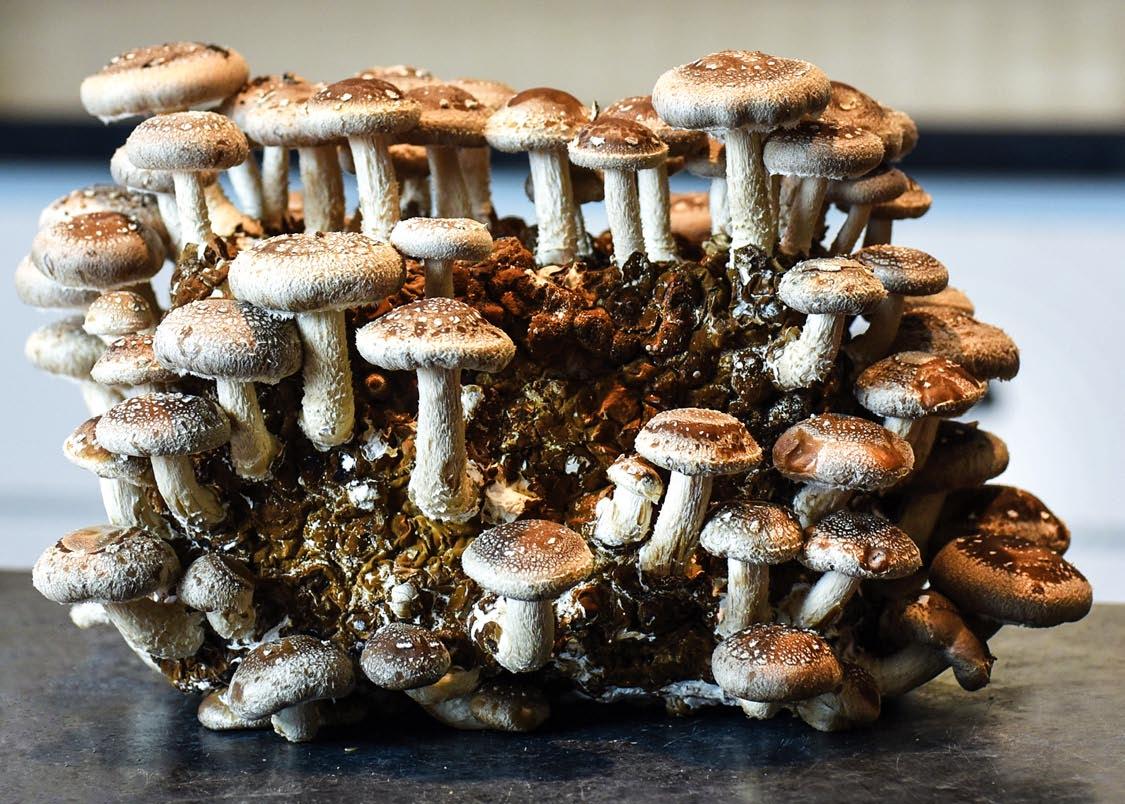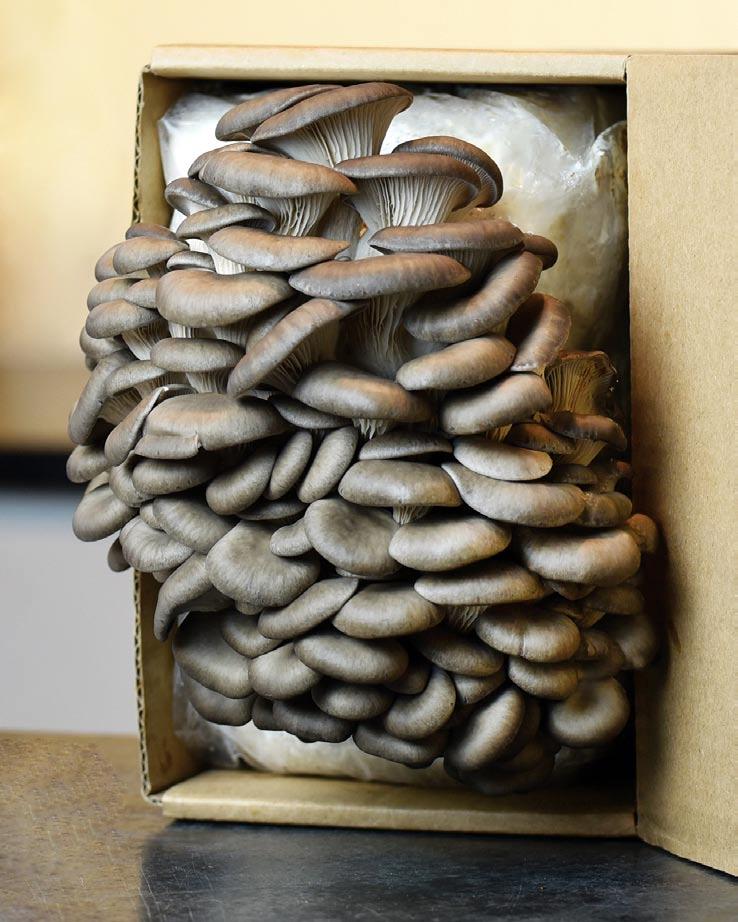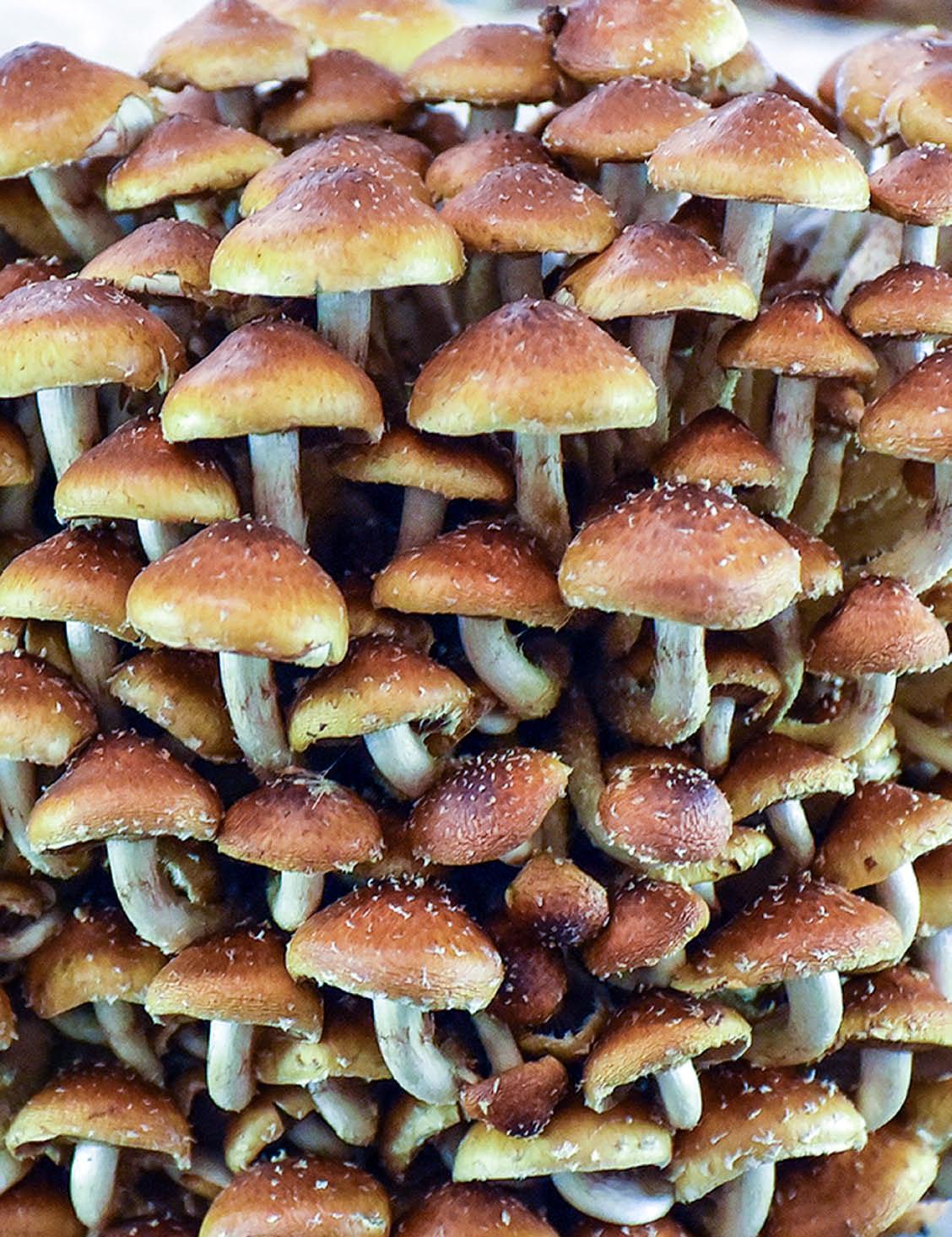
6 minute read
EDIBLEharvest
Marvelous Indoor Mushroom Kits
By Elizabeth Olson
Growing your own edible mushrooms indoors in the middle of a cold winter is great fun. It is convenient and increasing in popularity. Mushroom kits, in particular, are easy to use, have spacesaving designs, and can provide multiple crops of delicious and nutritious fresh mushrooms. Mushrooms from indoor kits are the above-ground fruiting bodies of various fungi. They can be prepared as a side dish or added to soups, stews, and many cooked dishes; see recipes on page 16. White button mushrooms and brown crimini mushrooms can be sliced fresh and added to salads. Mushrooms are low in calories and are a source of dietary fiber as well as several B vitamins and minerals, including phosphorous, potassium, and zinc. Shiitake mushrooms, in particular, have high levels of these nutritional elements and are a favorite vegetarian source of Vitamin D. The best time for ordering kits is generally from autumn until early spring each year. It is important to check shipping timelines with any supplier. Shipping in hot weather might not be available, since high temperatures can adversely affect the mushroom spawn. Kits should be ordered about two weeks ahead of needing them and then opened immediately upon arrival and set up according to package directions. Kits that arrive earlier than needed (such as those ordered as gifts) can be kept refrigerated from several days to weeks, depending on the species. A number of companies specialize in indoor mushroom kits; a selection is listed on page 15. The growing medium or substrate in mushroom kits is customized for each species and the medium is pre-inoculated and often has a whitish coating on the surface of the block. Another benefit of kits is that the medium is free of possible contamination from unwanted mushroom species.
Once a kit is opened and set up according to the kit’s instructions, with special attention to placement and light needs, mushrooms will start to sprout within one to two weeks. Many will be ready for harvesting in two to five weeks.
It is standard to harvest white button and crimini mushrooms, for example, at the immature stage before they become large and the gills open. Portabella mushrooms are the same species and brown form as crimini mushrooms, but are harvested when they are larger, more mature, and the gills have opened. The gills are usually left on the mushroom cap, although they can be gently removed with a spoon. Mushrooms do not keep well once they reach their ideal size and should be harvested as soon as they are ready. Surplus mushrooms can be dehydrated and they store well; they are easy to rehydrate. Second or later crops will grow in cycles. At the end of a kit’s pro-
Shiitake mushroom kit.
ductive life, the growing medium can be composted. Several well-known mushroom varieties are available in kits. The following varieties have a low difficulty level for gardeners. Humidity needs vary by species and are described in kit instructions. Each species has a preferred temperature range, but all will grow well at room temperature. • White button (Agaricus bisporus white color): It has a fresh and mild flavor when raw. The flavor deepens and becomes somewhat earthy when cooked. • Portabella/baby bella/crimini (Agaricus bisporus brown color): Raw crimini have a slightly deeper flavor than raw white button mushrooms. Cooked portabellas have a deep savory to earthy flavor. • Shiitake (Lentinula edodes): It is famous for its rich, woodsy flavor. • Oyster (Pleurotus spp.): The most common species, Pleurotus ostreatus, has a flavor that ranges from delicate and slightly sweet to a mild anise. • Lion’s mane (Hericium erinaceus): It is noted for its crab- or lobster-like flavor. • Chestnut (Pholiota adiposa): It has a nutty flavor. • Pioppini (Cyclocybe aegerita, syn. Agrocybe aegerita): It has a deep, earthy flavor.

Mushroom Kit Sources
• Cascadia Mushrooms Bellingham, WA CascadiaMushrooms.com 100% Certified Organic mushroom kits. Grow kits are available for blue oyster, cosmic queen oyster, shiitake, and lion’s mane mushrooms. Additional online recipes include mushroom burgers, mushroom risotto, and baconwrapped shiitake mushrooms.
• Far West Fungi San Francisco, CA FarWestFungi.com. Mini-farm mushroom kits are available for yellow oyster, pink oyster, shiitake, and lion’s mane mushrooms. Fans of Green Bean Casserole will appreciate the company’s online recipe featuring home-grown mushrooms. • Field & Forest Products Peshtigo, WI FieldForest.net. The company offers small, table-top mushroom kits. Varieties include the nutty-flavored Chestnut and the longstemmed Pioppini mushrooms in addition to king oyster, black oyster, lion’s mane, and shiitake mushrooms. There are many online recipes, including cream of shiitake soup, mushroom cobbler, and Chestnut mushroom and artichoke galette.
• Mushroom Adventures Marysville, CA MushroomAdventures.com. All mushroom kits are certified organic. Full-size kits are offered for portabella/baby bella/crimini, white button, and oyster mushrooms. Smaller kits are available for shiitake and lion’s mane mushrooms. The company has an option for double-boxing the kits for extra protection or gift-giving.
Mushrooms are surprisingly versatile. Enjoy growing your own from kits this winter. Experiment with different species and try various recipes or develop your own. Growing mushrooms from kits will provide an unexpected and delightful gardening experience. o
Oyster mushroom kit.
Elizabeth Olson is a Maryland Certified Professional Horticulturist. She is also an avid home gardener who is fascinated by the plants that she grows. She can be contacted through Washington Gardener Magazine.
All mushroom photos in this story are courtesy of Field & Forest Products, Inc. © 2022—All rights reserved.
Recipes
Salmon à la Shiitake Recipe courtesy of Cascadia Mushrooms.
Ingredients 1 filet wild salmon 1 lb. of shiitake mushrooms 1/4 cup of maple syrup 1/4 cup soy sauce 1 medium onion or shallot 1 sprig of rosemary
Directions Preheat oven to 350 degrees. Line a baking tray with aluminum foil; lay salmon skin-side down on the foil. Scatter rosemary over entire salmon fillet. Cover salmon flesh evenly with mushroom caps, gill-side down. Scatter onions/shallots evenly over salmon and mushrooms. Pour maple syrup and soy sauce evenly over entire fillet. Bake on oven’s middle rack for 20–30 minutes, until salmon is done (internal temperature should be 145 degrees F.). Use a fork to check thickest part of filet. Texture is best when flakey and slightly moist. Grilled Portabella Mushrooms Recipe courtesy of Mushroom Adventures. Let your mushrooms grow until the caps open. Remove the stem from the cap. Coat both sides of the cap with melted butter and olive oil, or oil-and-vinegar salad dressing (Italian). Salt and pepper to taste. Place the opened caps over a barbecue and grill for several minutes on each side. When cooked, the mushroom caps can be eaten whole, as a patty in a mushroom burger, or sliced and served as a side dish. This recipe can also be used with the caps pre-sliced into strips that are a half-inch-thick and marinated with the above ingredients before grilling. The stems can be saved and used in sauces or soups.

Lemony Button Mushrooms Traditional recipe. Slice white button mushrooms in half or in quarters, depending on the size of each mushroom. The mushroom pieces can be steamed until firm but tender. Another cooking method is to boil them; the mushrooms will release a lot of water, so be careful to add just enough water at the beginning to keep them from sticking to the pan. Finish the cooked mushroom pieces with freshly squeezed lemon juice and serve. Sautéed Portabella Mushrooms Recipe courtesy of Mushroom Adventures. Slice the mushroom cap and stem into long quarter-inch-thick strips. Sauté your mushrooms in a frying pan, adding a little butter and olive oil. Season with salt, pepper, and several diced cloves of garlic. Sauté your mushrooms for several minutes, until the water—which cooks out of the mushrooms—evaporates and the butter and olive oil remain in the pan. This may take a few minutes, but when you get to this point, your mushrooms will be done cooking and ready to eat.








